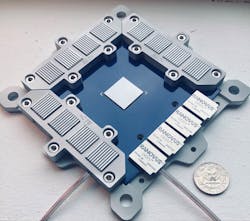Ranovus unveils single-chip Odin Analog-Drive CPO 2.0 Optical Engine for co-packaged optics
Having debuted its initial approach to co-packaged optics (CPO) at last year’s OFC (see "Ranovus announces single chip Odin silicon photonic engines for pluggable optical transceivers, co-packaged optics"), Ranovus Inc. is using OFC 2021 to announce a second-generation CPO optical engine. The Odin Analog-Drive CPO 2.0 Optical Engine offers significant cost and power savings over the first generation, Ranovus asserts. The company has again partnered with with IBM Inc., TE Connectivity, and Senko Advanced Components, Inc. to create a nx100G PAM4 CPO ecosystem based on the analog-drive version of Odin.
As the name implies, the new version of Odin leverages an analog drive approach rather than the digital drive of the previous generation. The analog approach obviates the need for retimers and therefore reduces cost and power consumption by 40% as well as chip footprint, Ranovus asserts. The new Odin also leverages the company’s 100-Gbps silicon photonics based Micro Ring Resonator modulators and photodetectors, a 100-Gbps driver, 100-Gbps transimpedance amplifier (TIA) and control circuity packaged in a single electronic-photonic IC (EPIC).
Contrary to what Lightwave erroneously reported in its recent digital edition cover story, the Odin EPIC leverages an external laser source, according to Hamid Arabzadeh, chairman, president, and CEO of Ranovus. The company plans to introduce a compatible laser source later this year, he added. That source might be placed on a separate shelf and connected via a four-connector system. In the other direction, the new design enables reuse of existing 100G PAM4 and PCIe SerDes chips instead of requiring a new XSR SerDes chip for connectivity, which the switch chip community favors, Arabzadeh asserted.
Arabzadeh added that he expects customer trials of the new analog-drive based approach to begin in the fourth quarter of this year.
For related articles, visit the Optical Technologies Topic Center.
For more information on optical components and suppliers, visit the Lightwave Buyer’s Guide.
To stay abreast of optical communications technology, subscribe to Lightwave’s Enabling Technologies Newsletter.

Stephen Hardy | Editorial Director and Associate Publisher, Lightwave
Stephen Hardy is editorial director and associate publisher of Lightwave and Broadband Technology Report, part of the Lighting & Technology Group at Endeavor Business Media. Stephen is responsible for establishing and executing editorial strategy across the both brands’ websites, email newsletters, events, and other information products. He has covered the fiber-optics space for more than 20 years, and communications and technology for more than 35 years. During his tenure, Lightwave has received awards from Folio: and the American Society of Business Press Editors (ASBPE) for editorial excellence. Prior to joining Lightwave in 1997, Stephen worked for Telecommunications magazine and the Journal of Electronic Defense.
Stephen has moderated panels at numerous events, including the Optica Executive Forum, ECOC, and SCTE Cable-Tec Expo. He also is program director for the Lightwave Innovation Reviews and the Diamond Technology Reviews.
He has written numerous articles in all aspects of optical communications and fiber-optic networks, including fiber to the home (FTTH), PON, optical components, DWDM, fiber cables, packet optical transport, optical transceivers, lasers, fiber optic testing, and more.
You can connect with Stephen on LinkedIn as well as Twitter.
